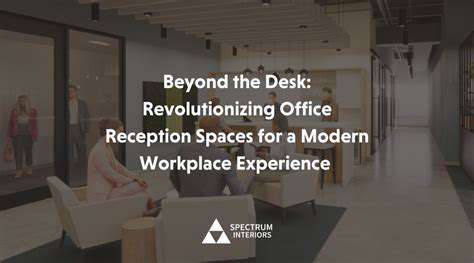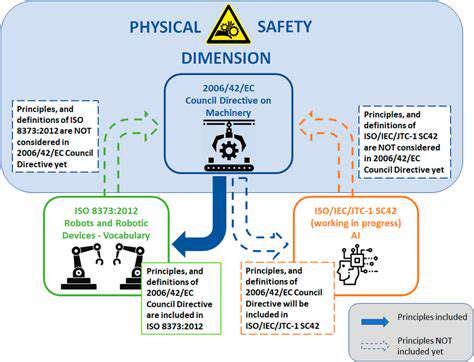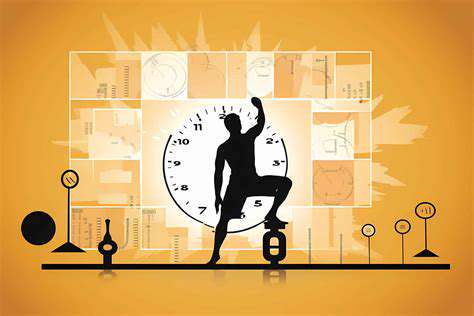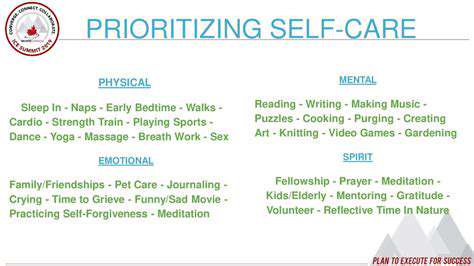How to Create a Healthy Workspace at Home

Defining Your Ideal Workspace: Functionality
A truly ideal workspace isn't just about aesthetics; it's about functionality. Prioritize a setup that allows for efficient workflow and minimizes distractions. This means considering factors like ergonomics, storage solutions, and the availability of necessary tools and equipment. A well-organized workspace fosters productivity and reduces stress, making it easier to focus on the tasks at hand.
Think about the types of tasks you perform most frequently. Do you spend hours hunched over a computer? Do you need ample space for papers and files? Understanding your workflow is key to designing a workspace that truly supports your needs.
Defining Your Ideal Workspace: Aesthetics
While functionality is paramount, aesthetics play a crucial role in creating a workspace you genuinely enjoy. A visually appealing environment can boost your mood and motivation, contributing to a more productive day. Incorporating elements that inspire you, like plants, artwork, or personal mementos, can transform a functional space into a truly inspiring one.
Consider color palettes, lighting, and the overall ambiance you desire. A calming color scheme might be ideal for focused work, while a more vibrant palette can help boost creativity. The right lighting can significantly impact your mood and comfort level.
Defining Your Ideal Workspace: Ergonomics
Ergonomics is crucial for maintaining both physical and mental well-being. An ergonomically sound workspace minimizes strain and discomfort, which can lead to increased productivity and a reduced risk of injury over time. Adjusting your chair, desk, and monitor to suit your body type is important.
Proper posture is paramount. An adjustable chair that supports your back, a desk at the correct height, and a monitor positioned at eye level can significantly reduce physical strain.
Defining Your Ideal Workspace: Technology Integration
In today's digital age, technology integration is essential for a seamless workflow. Consider the tools you need to perform your tasks efficiently, whether it's a high-speed internet connection, a reliable computer, or specialized software. A well-integrated technology setup streamlines processes, saves time, and improves overall productivity.
Efficient use of technology and software can significantly impact your ability to meet deadlines and perform your duties effectively.
Defining Your Ideal Workspace: Personalization
Beyond functionality and aesthetics, your ideal workspace should reflect your personality and preferences. Incorporating personal touches, like photos, artwork, or plants, can create a space that feels uniquely yours. This personalized touch can foster a sense of comfort and belonging, which can translate into greater motivation and focus.
Your workspace is an extension of you, so don't be afraid to make it your own. It should be a space where you feel comfortable and inspired to do your best work.
Defining Your Ideal Workspace: Sustainability
In today's world, sustainability is increasingly important. Consider incorporating eco-friendly materials and practices into your workspace design. This might involve using recycled or renewable materials, minimizing energy consumption, or adopting sustainable office supplies. Prioritizing sustainability not only benefits the environment but also demonstrates a commitment to responsible practices.
Sustainable choices contribute to a healthier planet and a more responsible work environment, potentially attracting environmentally conscious clients or colleagues.
Ergonomics: The Foundation of a Comfortable and Healthy Home Office
Understanding the Importance of Ergonomics in a Home Office
Creating a comfortable and healthy home office environment goes beyond simply finding a desk and chair. Ergonomics plays a crucial role in preventing discomfort, promoting well-being, and maximizing productivity. Poor posture and inadequate workspace setup can lead to a range of physical issues, from back pain and neck stiffness to eye strain and carpal tunnel syndrome. By prioritizing ergonomic principles, you can significantly reduce these risks and establish a workspace that supports your body's natural alignment throughout the workday, promoting both physical and mental well-being.
A well-designed home office considers the individual needs of the user. Factors like height, weight, and specific physical conditions should all be taken into account when selecting furniture and arranging the workspace. Careful attention to details like chair adjustability, monitor placement, and keyboard position can dramatically influence the overall comfort and health benefits of your home office setup. Investing in ergonomic solutions is an investment in your long-term health and well-being.
Implementing Ergonomic Principles for Optimal Comfort and Productivity
Implementing ergonomic principles in your home office involves more than just purchasing specialized equipment. It's about creating a workspace that adapts to your body's needs. Ensure your chair provides proper lumbar support, allowing your spine to maintain its natural curve. Adjust the height of your desk and chair to maintain a 90-degree angle at the elbows and knees. Position your monitor at arm's length to prevent eye strain and neck discomfort. Strategically place your keyboard and mouse close to your body to minimize reaching and strain on your wrists. These simple adjustments can significantly improve your comfort level and reduce the risk of developing long-term musculoskeletal problems.
Regular breaks are also a vital component of ergonomic home office setup. Taking short breaks every hour to stretch, walk around, and change your posture can help prevent stiffness and muscle fatigue. Remember, a healthy home office isn't just about the physical layout; it's also about incorporating mindful practices that promote body awareness and prevent prolonged periods of static posture. By consistently applying these ergonomic principles, you can create a home office that supports a healthy and productive work routine.
Consider incorporating a standing desk option for those who prefer to alternate between sitting and standing throughout the day. A standing desk allows for greater mobility and can help alleviate the strain of prolonged sitting. Additionally, ensure adequate lighting in your workspace to minimize eye strain and promote alertness. Good lighting can improve concentration and reduce fatigue.
Lighting and Ambient Sounds: Optimizing Your Sensory Environment

Lighting Design Considerations
Effective lighting design plays a crucial role in creating a welcoming and engaging atmosphere. Careful consideration of light intensity, color temperature, and distribution is essential for enhancing the overall experience. The right lighting can significantly impact mood and perception, influencing how viewers interact with the space and the content presented. Utilizing a combination of ambient, accent, and task lighting can create a dynamic and layered effect, highlighting key features and drawing attention to specific areas.
Different light sources emit different color temperatures, impacting the perceived atmosphere. Warm lighting, typically around 2700K, often evokes a cozy and intimate feeling, suitable for relaxation areas or spaces promoting social interaction. Cool lighting, with a higher Kelvin rating (e.g., 5000K), can create a more vibrant and energetic environment, ideal for areas requiring focus or a sense of alertness. Selecting the appropriate color temperature is paramount for achieving the desired ambiance.
Ambient Sound Design Principles
Ambient sounds, often subtle and background-oriented, can significantly enhance the immersive quality of an experience. These sounds, carefully chosen and integrated, can create a sense of place, evoke specific emotions, and even contribute to the narrative flow. Selecting appropriate ambient sounds is critical to enhancing the overall atmosphere.
Careful consideration of the volume and frequency range of ambient sounds is important. Excessive noise can be distracting and disruptive, hindering the user's ability to focus or enjoy the experience. Conversely, insufficient ambient sound can leave the environment feeling sterile and unengaging. A well-balanced approach, carefully calibrated to the context and the user's needs, is crucial for creating a positive auditory environment.
Integration of Lighting and Sound
The interplay between lighting and ambient sounds is crucial for creating a cohesive and immersive experience. A well-integrated design will seamlessly blend the visual and auditory elements, enhancing the emotional impact and overall engagement of the user. For example, a scene of quiet contemplation might benefit from soft, warm lighting and gentle, flowing sounds, while a bustling marketplace would require brighter, more vibrant lighting and a more lively, energetic soundscape. The goal is to create a harmonious and intuitive experience that complements the visual and auditory elements.
Careful consideration of the timing and pacing of both lighting and sound effects is essential. The gradual shift in lighting intensity and the subtle variations in ambient sound can create a dynamic and compelling narrative, further immersing the user in the experience. This carefully orchestrated interplay ensures that the experience is both enjoyable and memorable.
Organization and Decluttering: Maintaining a Clear Mind and Space
Defining Your Decluttering Goals
Before diving into the physical act of decluttering, it's crucial to establish clear goals. What are you hoping to achieve? Are you aiming for a minimalist aesthetic, a more organized workspace, or simply a reduction in the visual clutter that's been weighing you down? Understanding your motivations will provide direction and prevent you from getting overwhelmed by the sheer volume of items that may need attention. Clearly defined goals will help maintain focus and make the entire process more manageable.
Setting realistic expectations is equally important. Decluttering isn't about perfection; it's about progress. Aim for small, achievable steps rather than trying to tackle everything at once. This approach will foster a sense of accomplishment and encourage sustained effort throughout the entire decluttering process.
Identifying and Categorizing Items
A crucial step in decluttering is identifying and categorizing the items you possess. This involves sorting through everything from clothes and books to papers and personal belongings. Take your time in this process; rush will likely lead to missed items or a feeling of frustration. Categorizing will help you gain a better understanding of what you have and where it's currently located.
Consider creating different categories for various items. This could include keep, donate, sell, recycle, and trash. This structured approach will help you make informed decisions about each item and ensure that your space is organized effectively.
Creating Designated Storage Spaces
Effective decluttering goes beyond simply removing items; it involves creating designated storage spaces. This ensures that everything has a place to go, minimizing the risk of items accumulating in unwanted areas. Having designated storage spaces will significantly reduce the likelihood of clutter reappearing after the decluttering process is complete.
Careful consideration should be given to the type of storage solutions that best suit your needs. This could involve using storage containers, shelves, drawers, or even repurposing existing furniture to create more organized storage spaces.
Implementing a Consistent Decluttering Routine
To maintain a clutter-free environment, establishing a consistent decluttering routine is essential. This routine could involve weekly or monthly decluttering sessions, focusing on specific areas of your home or workspace. Regular decluttering sessions help prevent clutter from accumulating and ensure that items are properly stored and managed effectively.
Consider setting aside specific times during the day or week for decluttering. This will help you incorporate this important task into your schedule and make it a more manageable part of your routine. A consistent routine will help you stay on top of clutter and maintain a clear mind and space.
Prioritizing and Managing Sentimental Items
Often, the most challenging items to declutter are those with sentimental value. These items might hold memories or represent important relationships. Approaching these items with sensitivity and care is crucial. Consider creating a designated space for sentimental items, perhaps a memory box or a specific area of your home, to keep them readily available while maintaining a decluttered environment.
Maintaining Your Decluttered Space
Decluttering is not a one-time event; it's an ongoing process. To maintain a clutter-free environment, developing strategies for ongoing maintenance is key. This might include regularly checking for accumulating items, implementing a system for new acquisitions, and revisiting the decluttered spaces at regular intervals.
Establishing a system for returning items to their designated storage spaces and regularly assessing the efficacy of your decluttering strategies will ensure your space remains organized and your mind clear.
The Impact on Mental Clarity
Decluttering your physical space often has a profound impact on your mental clarity. A cluttered environment can lead to feelings of overwhelm and stress. By creating an organized and visually appealing space, you can foster a sense of calm and focus. This reduction in visual clutter can lead to a more peaceful and productive mindset, improving overall mental well-being.
A clear and organized space promotes a sense of control and allows for better concentration. This is particularly important for individuals who find it challenging to maintain focus or have difficulty managing their thoughts and emotions. Decluttering is more than just tidying up; it can be a powerful tool for improving your mental well-being.
Read more about How to Create a Healthy Workspace at Home
Hot Recommendations
-
*Guide to Managing Gout Through Diet
-
*Best Habits for Financial Well being
-
*How to Build a Routine for Better Mental Health
-
*How to Eat Healthy on a Budget [Tips & Meal Ideas]
-
*Guide to Practicing Self Acceptance
-
*How to Incorporate More Movement Into Your Day
-
*Guide to Managing Chronic Pain Naturally
-
*Guide to Building a Reading Habit for Well being
-
*Top 5 Weight Loss Supplements That Actually Work
-
*Best Exercises for Postpartum Recovery [Beyond Abdominal Work]











